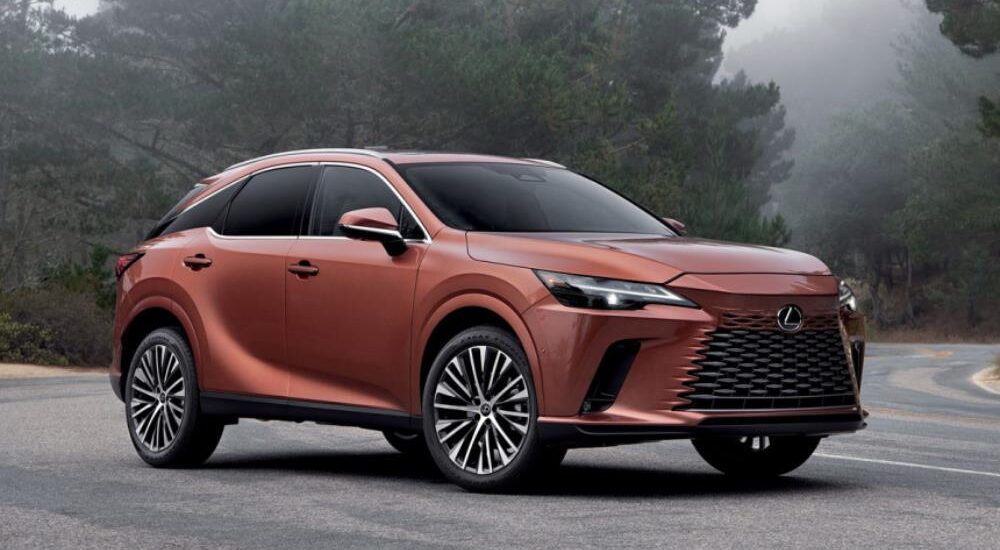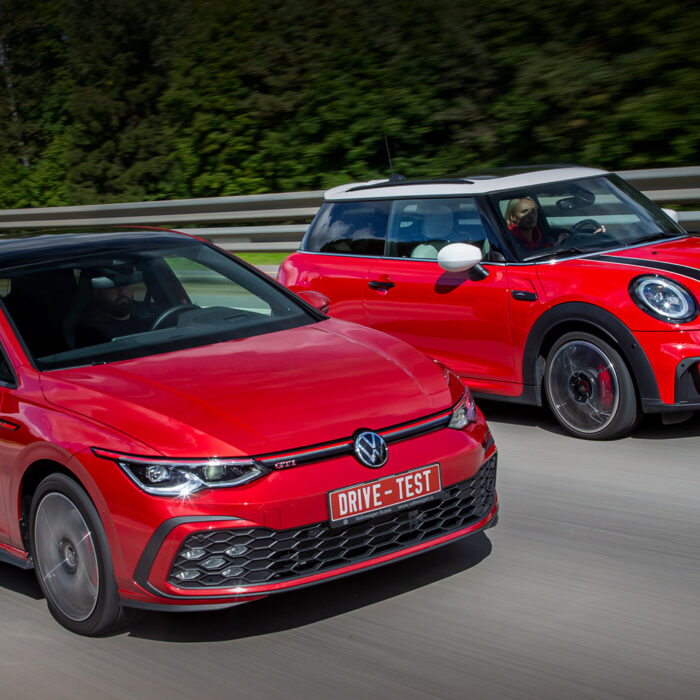When I first saw the fourth-generation Lexus RX, I thought I had come across a stealth fighter jet. And now, I got my hands on a test drive of the fifth-generation model: maybe it’s time for a change?
Regular readers know that I live in the American state of Florida. The most attentive ones might remember that I used to have a leased Honda Accord sedan. But after that publication, I had a radical change of heart – I bought a Ram 1500 pickup truck with a 5.7 HEMI V8 engine. A true compact apartment on wheels – my younger son could stand in the cabin, and it could accelerate to “a hundred” in just over six seconds with a menacing roar from its two exhaust pipes.
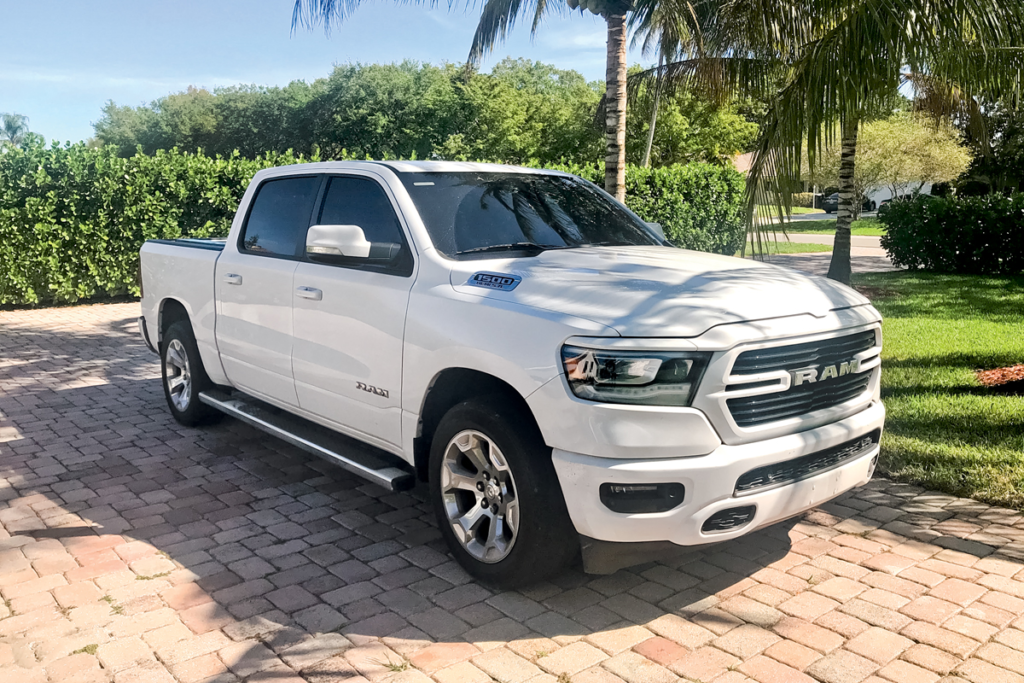
This Ram 1500 Longhorn 5.7 V8 gave me vivid emotions for over a year, but common sense prevailed.
I really enjoyed the Ram – every morning I would get behind the wheel with the excitement of the upcoming adventure. However, there was a big catch: 16 liters per 100 kilometers. On the highway. If you barely touched the accelerator pedal. And in regular city driving, the fuel consumption went far beyond 20 liters. So, when in the autumn of 2021, I stumbled upon a fresh Lexus RX 350 with only 20,000 miles on the clock for $35,000, I didn’t hesitate for long. True, I am 44 years old, while the average age of Lexus owners in North America is 55 years old. After all, firstly, people with above-average incomes can afford such a car, and building a career takes time. Secondly, at 55, you’re not old in America; it’s an age of blossoming, when you already have money and the desire to spend it hasn’t faded yet. I have seen elderly couples well beyond 80 in RXs. And I thought, “Why shouldn’t I join this club of silver-haired individuals, so to speak, ahead of schedule?”
But there was no chemistry with the “RX”.
With such a design, the car simply must break speed records, possess razor-sharp handling, glide through turns with minimal body roll, and stay glued to the road defying the laws of physics. But in reality, the Lexus is quite the opposite. It seems to be there on the steering, there are 300 “horses” under the hood that wake up periodically, and the automatic transmission is decent. But everything is somewhat smoothed out, lacking that spark. The car seems to whisper in my ear all the time: “Release the gas pedal, relax, put on some slow music… See, it works this way too.”

The previous, fourth-generation Lexus RX
By the way, stealth airplanes are also just okay flyers: for radar stealth, many flight characteristics are sacrificed. The same goes for the Lexus. And the design… If you take a closer look, several rules of good automotive design are broken here: short wheelbase, the front pillar aims not only past the front hub, but also past the entire wheel, a massive front overhang. The sides, scratched with multiple edges, even earned the RX a nickname “crumpled paper”.
However, all of this doesn’t prevent the “RX” from being a bestseller among premium crossovers in America. It’s obvious that the super task set before the creators of the fifth generation was something like this: do no harm. Don’t alienate the traditional audience. And if it’s possible to slightly expand it, even better. By the way, I’m sure that the task for the previous generation sounded pretty much the same.
The design of the predecessor was taken as a basis, although the “wrinkled paper” has been notably smoothed out. The length remained the same (4890 mm), but the wheelbase grew by 60 mm to 2850 mm. But the right proportions are still far away, as the entire addition came from moving the rear axle closer to the tail. And the meter-long front overhang remained in its place.

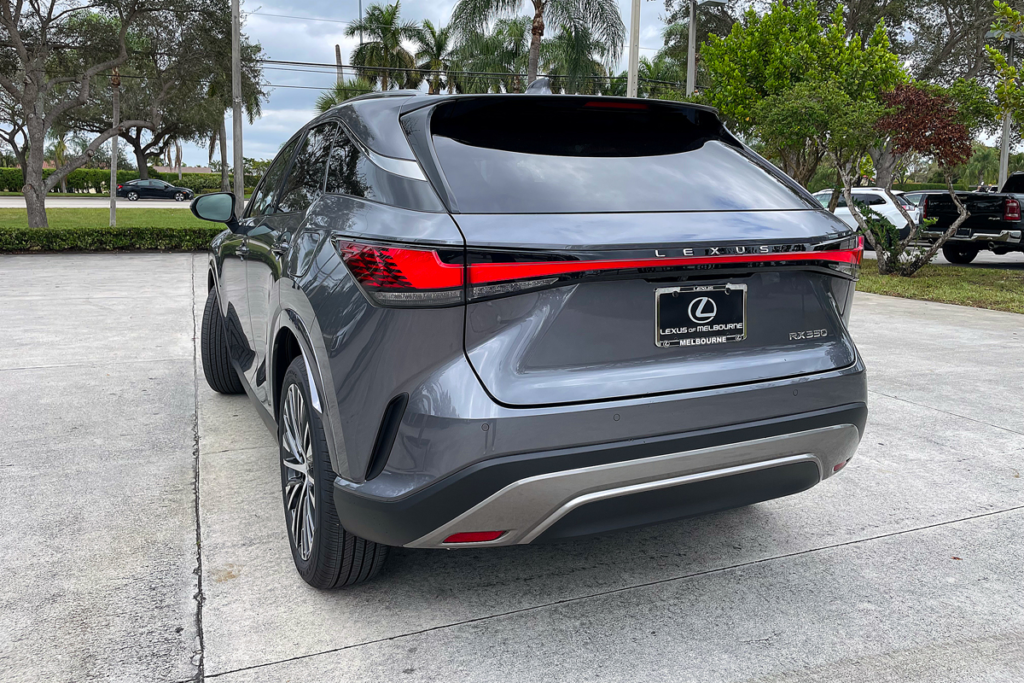
In profile, the new RX is absolutely recognizable, as the signature curve of the hovering roof remains almost unchanged. At the rear, there’s the fashionable LED monobrow, which has become an attribute of many Lexus models. And what happened to the trademark hourglass-shaped radiator grille? This is clearly a hint that the era of internal combustion engine cars is ending; most likely, the fifth generation will be transitional and final. The next step in evolution will be the closed front ends of electric cars, similar to the Lexus RZ electric crossover, which will probably take the place of the “RX” in the model lineup.

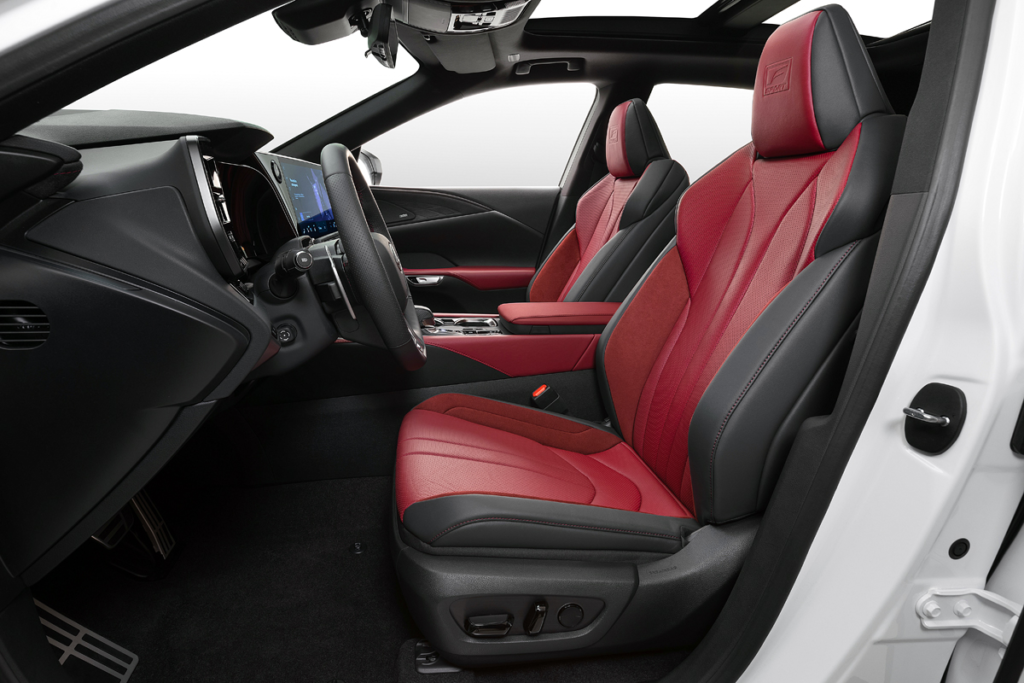
The seats are comfortable, and if you need firmer seats, then go for the RX F Sport
Getting behind the wheel of the gasoline-powered RX 350 feels familiar. It even seemed to me that the seats remained unchanged, but no – the side support around the shoulders is more pronounced. Even the font on the digital dashboard has been kept the same. Did they cut corners? I don’t think so – it’s more of a conscious decision not to require owners to adapt for too long. After all, how does it work in America? You lease a car, three years pass, and then the next generation is already here. Sign a couple of papers – and an hour later you’re driving off in a new car. The dealer will even help you transfer the small stuff from the old car to the new one.

The basic dark interior is pretty boring, but the light-colored seats and door card decor, combined with the interior of life, the most memorable and sad interior will be in the F Sport version
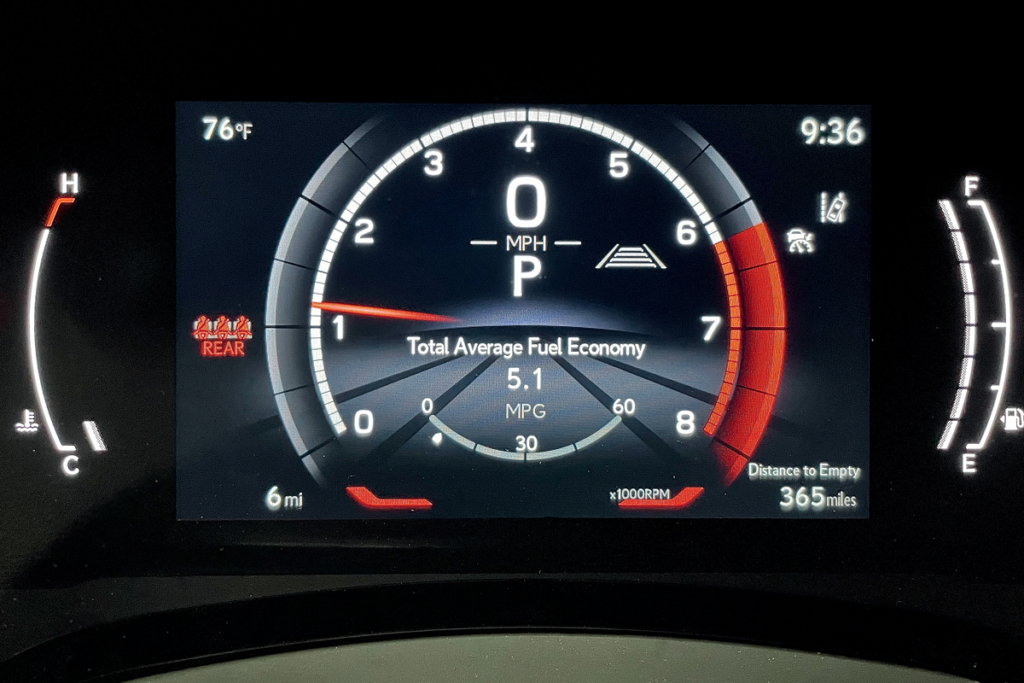
Virtual dashboard, comparing seven inches, clearly lagging behind the competition
Ergonomically, the new RX largely repeats its predecessor, with one significant exception. If before it was considered “not premium” to tap on the screen with your finger, and a joystick or an equally inconvenient touchpad acted as intermediaries, later Lexus gave in. To finger presses. Like Steve Jobs said, “We all have five styluses on each hand.” Modern kids even poke their fingers at TVs. And adults are not far behind.

The resolution of the rear view and all-round cameras has become higher, but many competitors still have better resolution

Wireless phone charging and USB-C ports for modernity
The base touchscreen has a 9.8-inch diagonal, while the optional one is a whopping 14 inches. The new Lexus Link Pro operating system is significantly faster than the previous one, has voice control, expanded online functionality, and remote access from a smartphone. However, it’s not exactly what you’d call state-of-the-art. This raises the question: why does everything Toyota and Lexus do become outdated even during the design stage?

On expensive versions, the navigation buttons on the steering wheel will be reassigned – and you can find out what they are responsible for using the projection display

Displaying remaptable button functions on the projection screen is always in view, but isn’t that too difficult for an RX owner?
The configurable buttons on the steering wheel can be quite perplexing. Their functions change depending on the task, and the current value is reflected on the instrument panel or using an optional projector on the windshield. It’s a bit complicated. By the way, dealers told me that some customers are still searching for the previous generation RX – those cars are still available.

However, there are also some pleasant nuances. The virtual climate control panel is conveniently located at the bottom of the display and never changes, making it easy to manage. However, the two physical temperature control knobs, located on either side of the screen, although they might be favored by conservative users, are quite easy to confuse with the Start/Stop button, which is positioned slightly above.
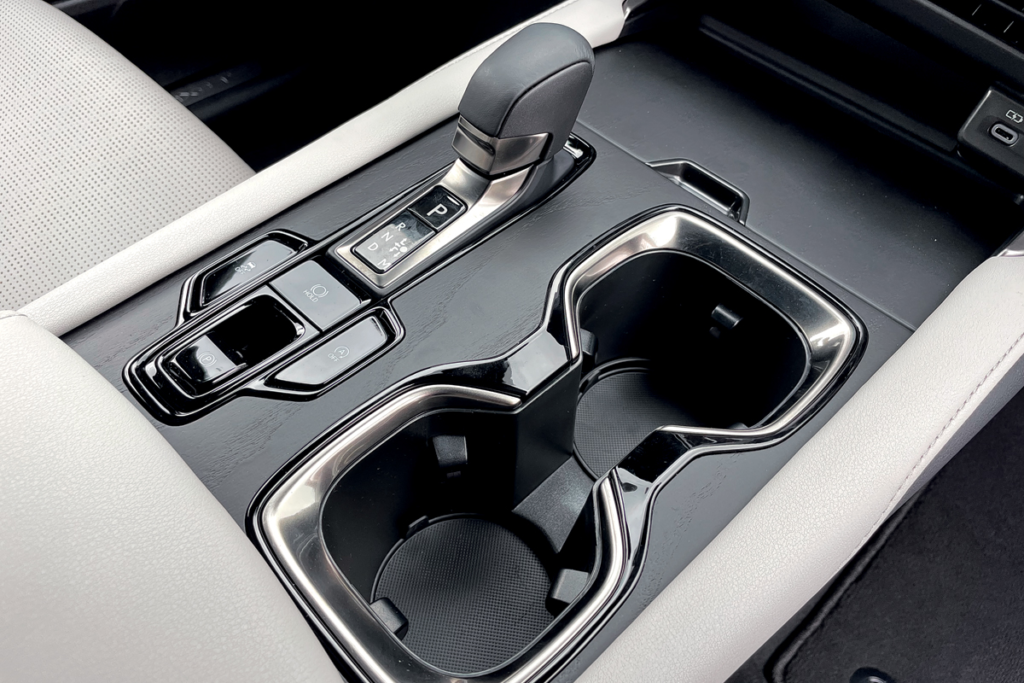
Inconvenient joysticks and touchpads are a thing of the past, but even the non-locking gear selector for the “automatic” transmission has become less straightforward – why was the P button separated?
Now, control of the transmission is handled by a non-locking joystick, whose operating algorithm is quite logical: towards you is “drive”, away from you is “reverse”. But blindly managing all modes, like before, is unlikely to work, as the Parking button is located separately.



When you open it from the outside, it looks like the door hasn’t been closed. From the inside, everything happens a little more naturally: pressing, a soft click – and the door is open
And the electric door locks e-Latch come with quirks: to open, you need to press a button on the inner side of the stationary handle. But from the inside, you just need to pull the handle, although the option for mechanical opening remains – in that case, you need to lift it and pull it towards you.
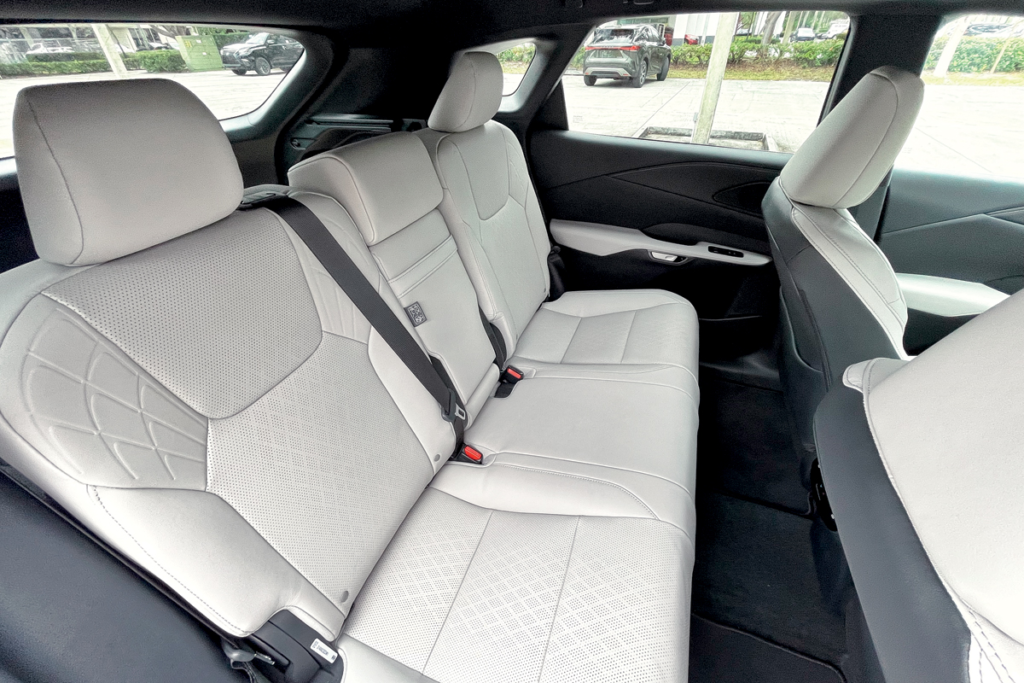
The distance between the rows of seats has increased by only 10 mm, and the landing has not changed much
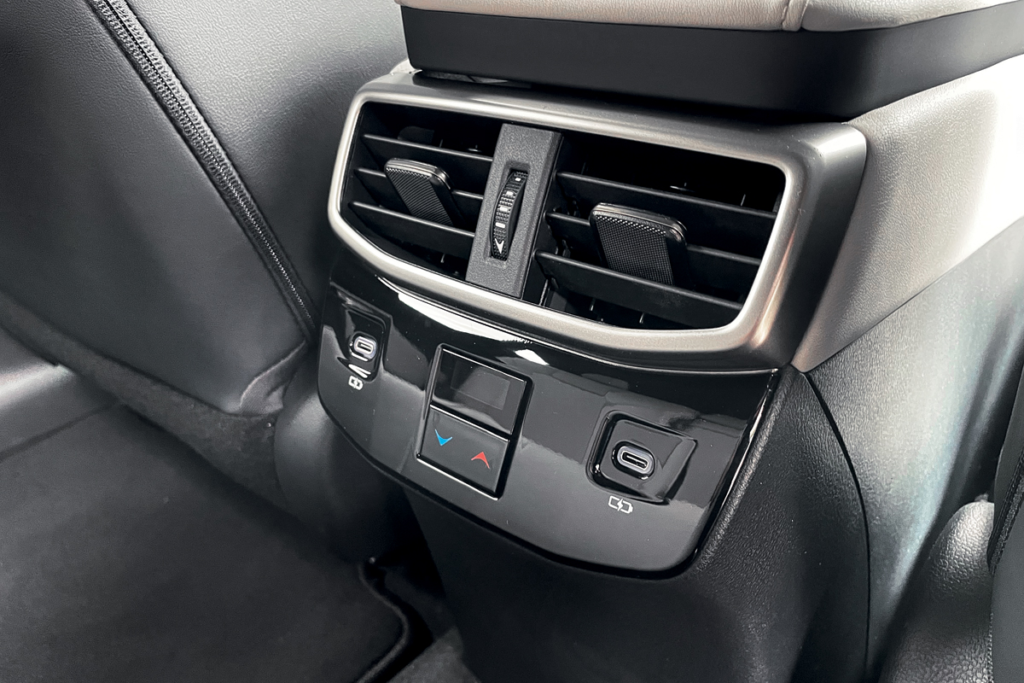
The third climate control zone is available in the base, for a surcharge – ventilation and heating of the second row
Why such twists and turns? The electronics might not execute the door opening command if it detects external danger. For instance, a cyclist approaching from the adjacent lane or another car. By the way, some versions have a driver monitoring camera above the steering wheel: the Lexus Safety System+ 3.0 electronic suite, which includes adaptive cruise control and numerous other assistants, can stop the car if it recognizes that the driver has fallen asleep or lost consciousness. So, what about the average age of the buyer, you say?

There are no more V6 engines in the lineup. Under the hood of the base version is a 2.4-liter turbocharged four-cylinder producing 279 hp and 430 Nm.
The version I tested was the RX 350, but now, under the hood, instead of the 3.5-liter naturally aspirated V6, there’s a 2.4-liter turbocharged four-cylinder. It’s slightly less powerful, at 279 hp, compared to the previous 299 hp. The main change for me is the engine sound: instead of the noble timbre of the old atmospheric “six,” you now hear the rattle of a four-cylinder at idle. On paper, the acceleration to a hundred is a second faster (7.1 seconds) due to increased torque, and when you floor the accelerator pedal from a standstill, the new RX 350 really puts in more effort. But during normal accelerations, I didn’t feel any extra zest – this might be due to the appearance of turbo lag. Furthermore, the new engine is slightly more fuel-efficient and can achieve about 10 liters per 100 km, although my RX 350 is not that fuel-hungry – around 12 liters per 100 km.

The steering-wheel-mounted paddles for Lexus are like a fifth leg to a dog – I have no desire to shift gears manually with them.
With the transition to the GA-K platform, the crossover has acquired a rear multi-link suspension instead of the previous McPherson struts, and the center of gravity has been lowered. The body has become stiffer, while the fenders and hood are made of aluminum, making the new RX 90 kg lighter than its predecessor. The front track is now 15 mm wider, and the rear track is a full 50 mm wider, giving the Lexus a somewhat Mercedes-Benz GLE-like rear appearance, which also features a wide stance.
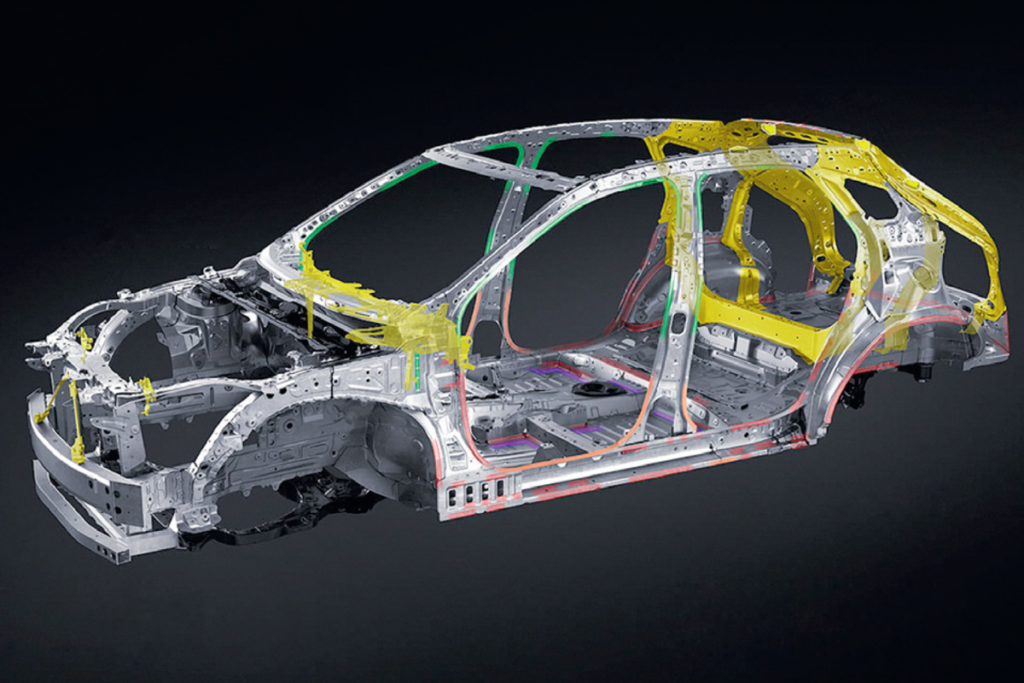
The body is now stiffer: for the reinforcements of the sills, steel with a strength of 1180 MPa was used, and for the roof reinforcements – 1470 MPa. The fenders and hood are made of aluminum.
The RX still holds its line perfectly, and there are plenty of straight roads in America. The suspension has become a bit firmer at handling speed bumps, and the body roll has decreased slightly. However, overall, I can’t say that the difference between the old and the new is so significant that it’s noticeable – especially for the typical Lexus buyer.

The new multi-link rear suspension instead of McPherson struts at the rear axle aims to improve handling.
Yes, the Lexus RX has never been – and probably never will be – a truly driver-focused car. Despite its appearance. However, in the advertising campaign for the new generation of the “RX,” Lexus emphasizes the wide range of electrified versions. The most accessible hybrid is the RX 350h, which features a 2.5-liter four-cylinder in combination with an electromechanical continuously variable transmission: a total of 245 hp and 6.5 liters per 100 km in the combined cycle. The optional E-Four full-time all-wheel drive system is achieved through a separate electric motor at the rear axle.
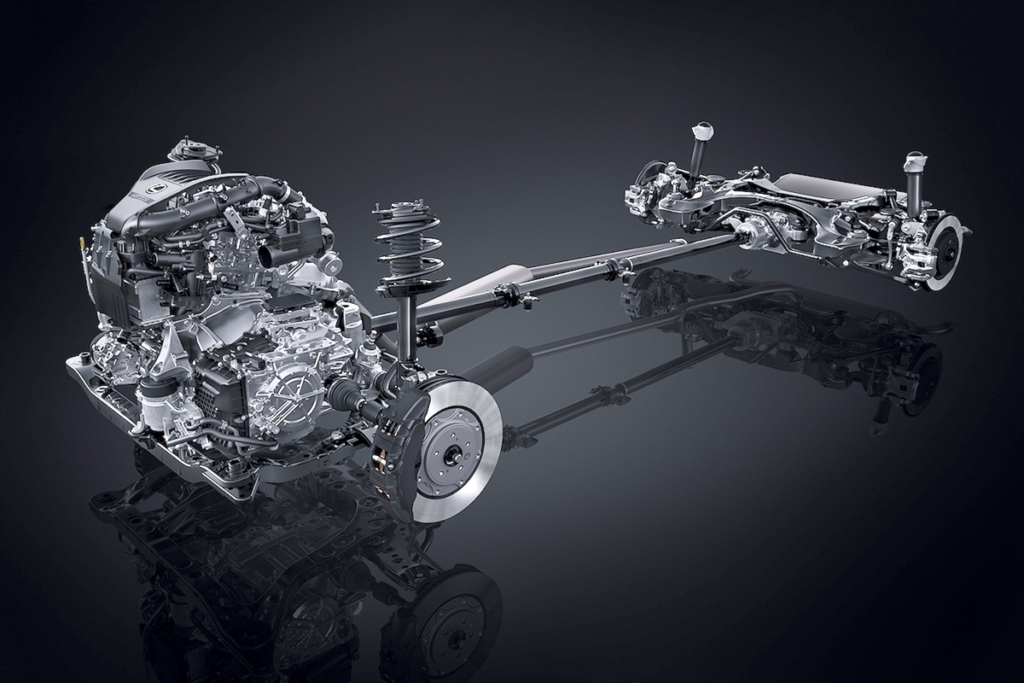
The base RX 350 can be either front- or all-wheel drive – with a clutch on the rear axle

The hybrid version has an atmospheric “four” 2.5 under the hood. The battery of 216 battery cells is located under the rear seat, and the optional E-Four all-wheel drive is implemented by an electric motor on the rear axle
The RX 450h+ version is already a plug-in hybrid with the E-Four all-wheel drive and more powerful electric motors with a combined output of 306 horsepower. Moreover, the 18.1 kWh lithium-ion battery provides a 65-kilometer all-electric range. And at the top is the Lexus RX 500h F Sport Performance: a 2.4-liter turbocharged engine and a six-speed automatic transmission with a clutch instead of a torque converter. Yes, on this version, the Toyota folks abandoned their signature electromechanical planetary gear-based CVT! This is practically a revolution, as the RX 500h became the first Lexus hybrid with a turbocharged engine (a similar scheme appeared slightly earlier on the body-on-frame Toyota Tundra and Sequoia). And instead of developing a new generation of planetary CVTs for higher torque, the Japanese simply surrendered – after all, the era of “pure” electrification is ahead. Well, the hybrid era of Toyota, which started with the Prius in 1997, lasted over a quarter of a century, so it’s time to move on.
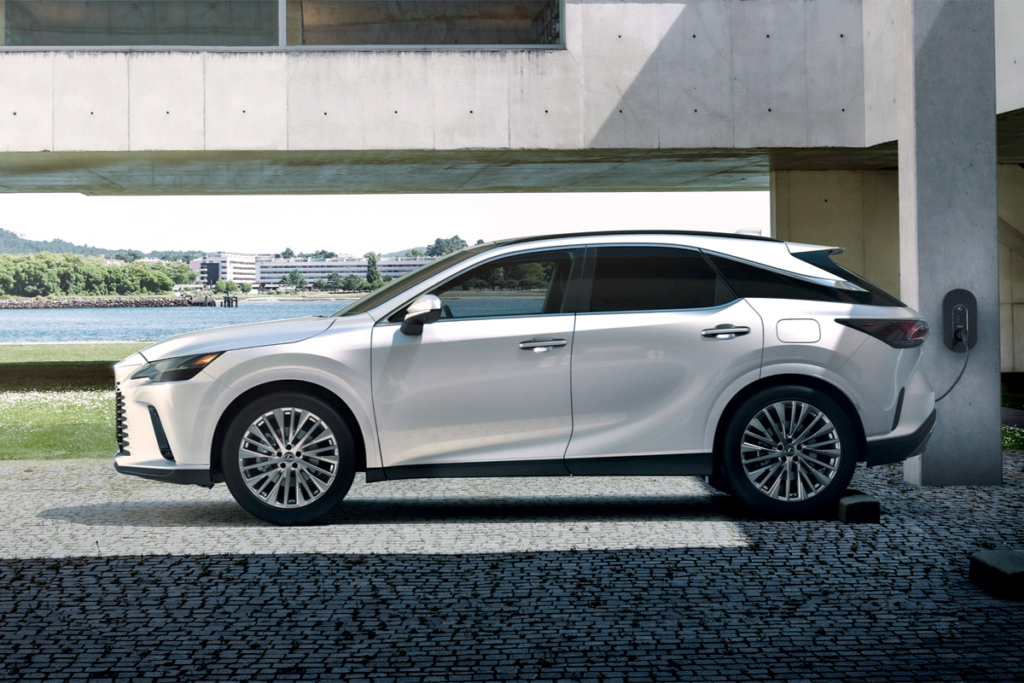
The plug-in hybrid RX 450h+ with all-wheel drive will arrive a bit later. It combines a 2.5-liter turbocharged four-cylinder with an 18.1 kWh lithium-ion battery under the floor and a rear E-Four motor.
Interestingly, the top-tier RX 500h F Sport Performance has a rear module with an electric motor generating 109 hp and a traction battery from the new RZ 450e electric car: standardization! The combined output is 371 hp and 550 Nm, with a 0-100 km/h acceleration time of around six seconds. Additionally, the RX 500h F Sport Performance features a fully controlled chassis and six-piston front calipers. It would be interesting to take a ride in that, wouldn’t it?
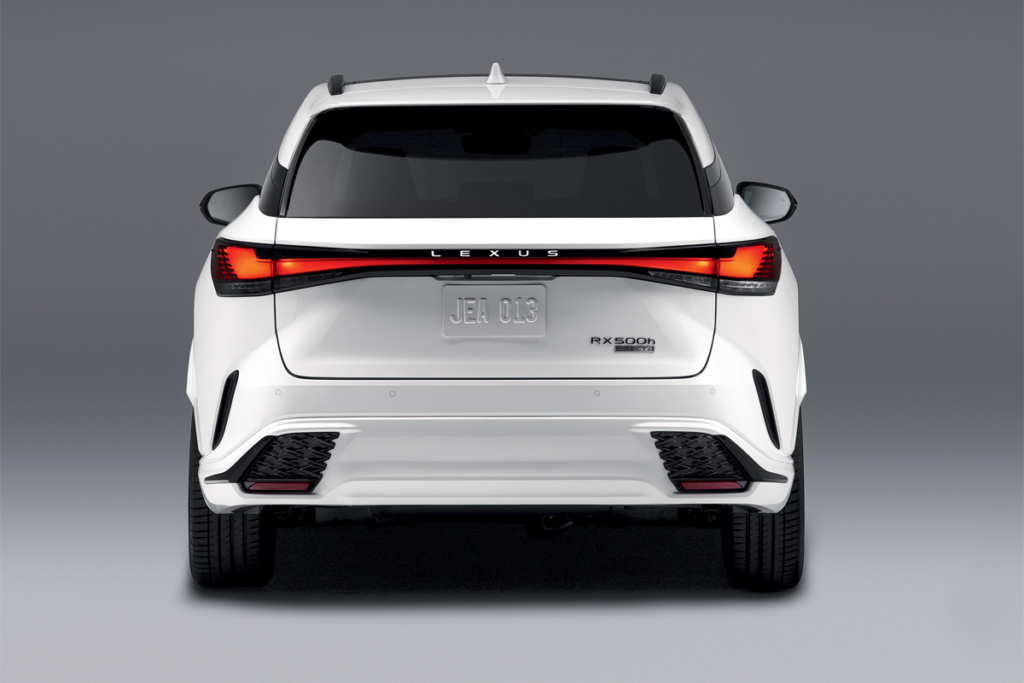
The RX 500h is a parallel hybrid with a Direct4 all-wheel drive system that automatically distributes torque between the front and rear axles in a ratio of 100:0 to 20:80

By the way, the extended Lexus RX L didn’t make it into the new generation lineup. However, this year, a separate model, the Lexus TX, with three rows of seats will be introduced.
So, why is the new RX still popular? Yes, it has become slightly sportier, more composed on the road, and it has more electronic gadgets. But the main aces in the deck remain the same: price, reliability, resale value, and size. After all, Lexus and Toyota are leaders in terms of reliability and residual value, which means that the money spent on the car can be easily and quickly recovered. Furthermore, the RX is cheaper than the German allowing it to attract customers not only from direct competitors but also from lower-class models. Lexus competes with almost all premium crossovers in the range of $40,000 to $70,000, which accounts for a significant portion of the market. American prices start at $48,550 for the base front-wheel-drive RX 350 and go up to $62,750 for the RX 500h F Sport Performance, excluding taxes and delivery. For comparison, the most affordable BMW X5 sDrive40i will cost the buyer $61,600, but it’s more dynamic than any RX. The Mercedes-Benz GLE 350 with a two-liter turbocharged engine is slightly more affordable at $57,700, but it’s also slower.

The trunk has increased compared to its predecessor and reached a volume of 461 liters according to the European specification

In the underground – light-alloy spare tire
As a result, stable sales of 100,000 to 110,000 RX vehicles per year, despite financial crises or pandemics. This is the most popular premium crossover in the North American market. In Russia, the RX also led with a significant margin… in the past.
Will I trade my RX 350 for the new one? Definitely not. Firstly, Lexus is still not for me, I’ve certainly understood that now. And the second reason is financial. American regulators raised the key interest rate to combat inflation, which surged to an inappropriate 6.5% after the pandemic. Today, you can get a car loan at best at 6-7% per annum, assuming you have a good credit rating. Not that it’s unaffordable… It’s more psychologically unusual. After all, the interest rate on my loan was 4% a year and a half ago. Remember how much I paid for the leased Accord? Yes, $297 a month. Forget about it: today, you’ll have to pay one and a half times more for the exact same car, and the RX 350 will cost over a thousand a month.
So, for now, I’ll keep driving the fourth-generation RX, which I pay only $620 for, and its value has barely dropped.

| Car | Lexus RX 350 |
| Body Type | Five-door SUV |
| Dimensions (mm) Length Width Height | 4890 1920 1710 |
| Wheelbase | 2850 |
| Front/ Rear Track | 1655 / 1690 |
| Ground Clearance, mm | 205 |
| Approach/ Departure Angle, degrees | 15 / 25 |
| Luggage Compartment Volume (SAE method), l⠀ | 838—1308* |
| Curb Weight, kg | 1915 |
| Gross Vehicle Weight, kg | 2549 |
| Engine | Gasoline, with direct and turbocharged injection |
| Position | Front, transverse |
| Cylinder Arrangement | Inline 4-cylinder |
| Displacement, cm³ | 2393 |
| Bore / Stroke, mm | 87.5 / 99.5 |
| Compression Ratio | 11.0:1 |
| Number of Valves | 16 |
| Max Power, hp/kW/rpm | 279 / 205 / 6000 |
| Max Torque, Nm/rpm | 430 / 1700—3600 |
| Transmission | Automatic, 8-speed |
| Drive | All-wheel drive, with a multi-plate clutch for the rear wheels |
| Front Suspension | Independent, spring, McPherson |
| Rear Suspension | Independent, spring, multi-link |
| Brakes | Ventilated disc brakes |
| Base Tire Size | 235/60 R19 |
| Maximum Speed, km/h | 200 |
| 0-97 km/h Acceleration Time, s | 7.2 |
| Fuel Consumption, l/100 km Urban Cycle Extra-Urban Cycle Combined Cycle | 11.2 8.4 9.8 |
| Fuel Tank Capacity, liters | 67.5 |
| Fuel | Gasoline (AI-95—98) |
*With rear seats folded down
Photo: Alexey Dmitriev | Lexus
This is a translation. You can read the original article here: Новый Lexus RX и его стелс-технологии. Наш тест в Америке

Published October 11, 2023 • 29m to read

